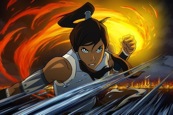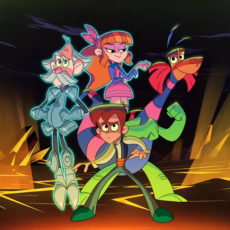Entertainment Distributors/Filmation Studios/Atlantic Releasing/JVC (November 22 1985), MGM DVD (June 21 2005), single disc, 100 mins, 2.35:1 anamorphic widescreen, Dolby Digital Stereo Surround, Rated PG, Retail: $14.98
Storyboard:
Set on the subterranean Mine-World, a band of human worker-slaves under the power of the black-caped evil overlord Zygon (who’s obviously a fan of the Temple Of Doom’s decorator) continue to hack away at their worthless lives until one, Orin, unearths the hilt of a mythical lightsabre-esque sword that it seems only he can master. Escaping the planet, he runs into the rogue smuggler Dagg (who seems to be based on an uncredited Burt Reynolds!), and a pair of helpful droids (the ship’s computer and a Fembot), along with the obligatory princess (sound familiar yet?), who all team up to return to the Mine-World, defeat Zygon and free Orin’s enslaved people. Throw into the mix your classic dark-caped villain (and his fully operational battle station), a wizened ghostly keeper-of-the-sword’s-power figure, an army of robots who seem to have strayed from The Black Hole (remember Captain S.T.A.R.R.?) and some nifty spaceship battles, and that pretty much covers Starchaser’s plot.

The Sweatbox Review:
Before Treasure Planet, Atlantis: The Lost Empire or Titan AE (but certainly after Star Wars, the animated Lord Of The Rings, Logan’s Run, The Black Hole, Tron, Indiana Jones And The Temple Of Doom and Blade Runner), the animated sci-fi epic on the block was Starchaser: The Legend Of Orin, which fuses elements from a variety of sources and regurgitates them into an enjoyable slice of interplanetary hokum.

The plot is derivative of most of the films mentioned above, as those who have seen it are quick to point out, though without also commenting that it doesn’t really matter and brings several new essentials to create a story in its own right. That argument just about holds up, though it is fun to pick out and be reminded of similar elements in similar films. For those who haven’t seen it, think about it as “Skywalker: The Legend Of Luke”, and you’re kind of half way there.
Then again, and to be fair, saying that Starchaser is a Lucas copy-cat when he himself plundered the depths of Saturday morning matinees and 1930s sci-fi, is a little harsh. Starchaser does serve up a few unique ideas of its own that would be referenced (intended or not) by later projects, significantly Titan AE, to which this bears most similarities, and it could be said that the villain’s comeuppance here certainly “foreshadows” The Phantom Menace, bringing things back full circle in a way. Indeed, if you enjoyed Titan AE, chances are you’ll get a big kick out of Starchaser. The animation styles of both films (as with Atlantis: The Lost Empire) suggest the comic book look of the Filmation shows of the 1970s, as well as Hanna-Barbera’s Johnny Quest.
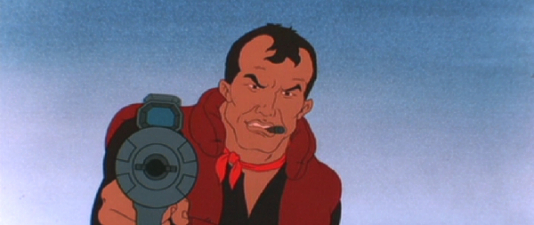
Going in, I was worried that it might have that same TV level static quality approach, but I am more than happy to report – and was fairly surprised – that the animation holds up very well, being drawn mostly on twos for essentially full fluidity. Of course, what is achievable today does outshine the efforts of this low-budgeted crew, but the faces have fun personality, and there is obvious effort to give movements meaning, getting away from the overly elaborate humans of Heavy Metal and Rock And Rule, or the hopelessly rotoscoped look of Ralph Bakshi’s Wizards and Fire And Ice, to which Starchaser is very much a companion piece, though with much less flesh on show. Backgrounds are a mixture of standard starscapes, washy layout paint jobs and some very richly detailed planetary environments, finely rendered and reminiscent of the art found in those glossy fantasy sci-fi books of the 1980s.
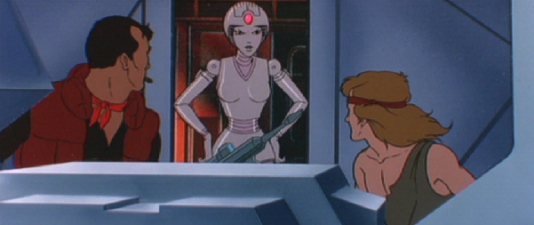
It may not be quite on par with Disney’s offering for the same year, The Black Cauldron, but that wasn’t a totally successful film in its artistry either, and at least Starchaser contains some new layout ideas and interesting character designs. Reading up on the release, it seems Filmation did play a part in the animation, though the company isn’t listed on the film itself. Thankfully, it doesn’t seem to have been farmed out to cheap animation companies either, and some of the names featured in the credits have gone on to greater things: among them most notably are Bill Kroyer, who along with John Lasseter was a CGI pioneer that went on to become a director (of the great short Technological Threat, the feature FernGully, and supervisor of effects for such films as Scooby-Doo and Garfield), and Darrell Rooney, mostly known for directing direct-to-video sequels to The Lion King, Lady And The Tramp and Mulan.
Also in the animation line up are veteran animator Tom Sito, who has since hopped between Richard Williams’ studio (on Raggedy Ann And Andy, Ziggy’s Gift), Disney (Lion King, Pocahontas, Roger Rabbit, Aladdin, Dinosaur, Fantasia/2000), DreamWorks (Prince Of Egypt, Antz, Spirit, Shrek) and Warners (Osmosis Jones, Looney Tunes: Back In Action, Son Of The Mask) and is now President of the Motion Picture Screen Cartoonists guild, and Chris Bailey, recently of the Clerks cartoon series, Mickey’s Runaway Brain short and the Kim Possible show. Making perhaps the biggest jump is Don Ernst (here credited as editor and sound designer), from being a film editor of such shows as Gilligan’s Island, Wild Wild West and Gunsmoke, to big screen feature Le Mans, and a long spell at Ralph Bakshi’s on Heavy Traffic, Coonskin, Wizards, Lord Of The Rings, Hey Good Lookin’ and Fire And Ice. And that jump I mentioned? Well, these days Ernst has truly joined the establishment, co-producing Aladdin, Fantasia/2000 and Destino for the Disney Studios!

Of the other main crew, presenters Thomas Coleman and Michael Rosenblatt don’t really have anything else to their credit other than The Garbage Pail Kids Movie and Teen Wolf between them that are anywhere near approaching Starchaser’s genre, and director Steven Hahn seems to have disappeared off the radar completely, only producing short-lived TV show Little Dracula in 1991 and the Tillie’s Dragon special in 1995. It’s a shame he hasn’t gone on to at least a sub-Don Bluth career, since his staging here reveals some good ideas and some nice touches, sometimes unneeded, that help add to the epic nature of the look of the film. Serving up more credibility with past and future experience is composer Andrew Belling, another Bakshi Wizards alumni who would go on to become a long time composer of underscores for Disney compilations, including the series Sing Me A Story With Belle. Writer Jeffrey Scott is likewise a solid industry insider, contributing to a plethora of well-regarded TV shows such as Challenge Of The SuperFriends, Spider-Man, Dungeons And Dragons, Muppet Babies, MASK, James Bond Jr, and Teenage Mutant Ninja Turtles, and here serving up a fun mix of all those kinds of elements.

To the film’s credit itself is its decision to play to the teenage/adult crowd. There’s a fairly harsh on-screen death within minutes the film starting, and a surprising amount of violence throughout. Surprising? Hang on, let me re-phrase that, as I fell in to that old trap of thinking this was an animated film for kids – the fact that Starchaser has been issued on MGM’s regular DVD film label as opposed to the child-friendly MGM Kids line should alert one to the fact that this is a more “seriously toned” animated film, with subsequently hard language (though it’s PG rated, so nothing approaching real profanity). Hahn keeps things moving well, with a story that never gets too bogged down, and a universe of fresh characters (whatever their borrowed ancestry). Adding to the visual aspects are the space battles, created using wireframe computer models (by Kroyer and Bailey among others) and animated (as with The Great Mouse Detective’s Big Ben sequence) by hand-coloring over the print outs. This makes for some impressive shots that really bring these scenes to life and help the film stand up well in the intervening years.
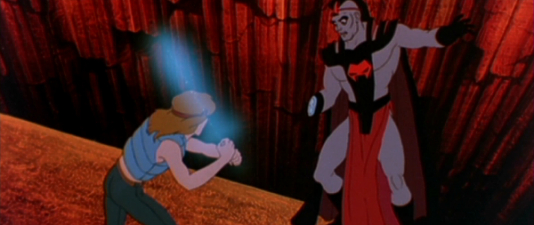
Starchaser is a good, fun, well-made picture. It’s certainly of its time, highlighted by its score, which swerves from electronic-styled John Carpenter synths to full on John Williams spacey strings and a bombastic orchestral brass main theme, but is a enjoyable ride that doesn’t sink into confusion as so many of the 1980s Star Wars knock-offs seemed to do. Before the flood of Japanese manga animes took over, Starchaser was a sole, bold departure from the family friendly Disney-dominated world of American animated features. It’s certainly its own animal, and is a good example of the old-style Saturday morning cartoon approach kicked up a notch or two for theatrical exhibition.
Is This Thing Loaded?
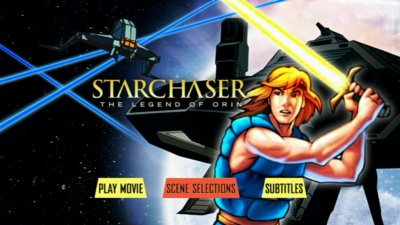
Given the film’s background as a 3D event movie, and its status as one of the rare ’Scope-shaped features (it was, along with The Black Cauldron, one of these two films that were the first widescreen animated films to have been made in 25 years), I was hoping for at least a glance into its production history or the pioneering use of computer wireframe animation. What MGM gives us is the barest type of bare bones disc imaginable, with not even the fullscreen transfer and original theatrical trailer that were alluded to when the title was announced showing up for duty. Also missing are any kind of production notes, crew biographies or anything of interest other than a couple of foreign language subtitle tracks.
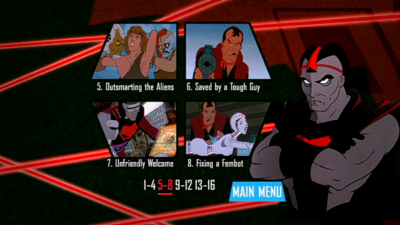
The lack of anything (the MPAA piracy promo doesn’t count!) is a real shame – there’s also nothing drawing attention to the fact that this is Starchaser’s 20th Anniversary, which is surely the grounds for some kind of decent treatment – though for once MGM is to be applauded for actually presenting a film in its original aspect ratio, something The Lion is well known to slip up on with its catalog titles from time to time. A badly missed opportunity.
Case Study:
Starchaser: The Legend Of Orin is a well made animated film, bearing in mind the 1985 release date, so don’t let the simply drawn front cover image or the lack-lustre stills on the back put you off! There’s also – surprise, surprise – no insert to even earn the package some marks in that respect. The barest of the bare.
Ink And Paint:
Originally presented as part of the early 80s revival of 3D feature film releases that included Jaws 3-D and SpaceHunter: Adventures In The Forbidden Zone, Starchaser was also released regularly to theaters in a 2.35:1 widescreen ratio, which is what MGM gives us here. The slightly soft image doesn’t always cover up the 1985 age of the film, but if I didn’t know any better (and apart from a few cel scuff marks) I’d have said it was a digital transfer due to the lack of grain and a solid, stable picture that shows zero signs of any gate weave. Less exciting is the framing, which looks okay for the most part, though some shots are decidedly tight top, bottom, left and right, which might point to the film being shot to a taller negative (1.66:1?) and printed to the wider frame for distribution.
In this rare case, I would have been interested to see a fullscreen edition bunged on the same disc (and as was mentioned in original press notes for this disc) to see if it indeed added anything top and bottom or further cropped left and right. However, it is also more than likely that the film was simply completed on taller boards with some guesswork involved on the part of the animators to animate within the frame area. It’s not a major problem by any means, and only a handful amount of shots suffer, but it’s noticeable when it occurs. I’d be interested to hear from anyone who knows more on this, whether it’s a production or disc issue, but otherwise, this is a spotless, strong transfer.
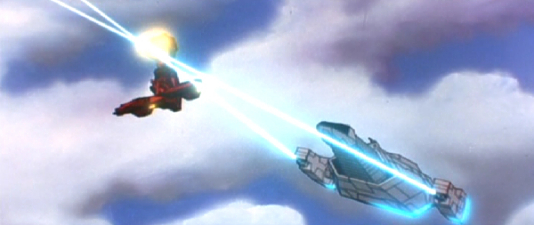
Scratch Tracks:
Befitting its big screen, epic status, Starchaser was created with a blockbuster Dolby Surround mix, here presented as a Pro-Logic (4.1) track. As good as the image looks, the audio just about holds up as well, with a mix, while nowhere near as aggressive as what we’re used to now, that is full of fun (and familiar!) sounds that zip in and out of speaker range. Voices, from a selection of no big, but fitting character actors who always sound convincing – the only one I recognised was Police Academy’s Michael Winslow – are clean and processed free of any interference. The electro/orchestral score is reproduced as well as any other film from this time, with a pleasing amount of depth. English, French and Spanish subtitles are included.
Final Cut:
Up until now, Starchaser’s reputation as something of a cult film and the brief looks I had seen of it over the years had not entirely got me gagging to see it. Now that I have, I’m sorry I missed it first time around. Nothing will stop fans of the film from picking it up – if they haven’t already – and the widescreen, stereo surround presentation is the best the film will have looked and sounded in a long time. The lack of any extras may put off those who sit on the fence over such blind buys, but the ridiculously low price point (available for around $10) means it’s more than worth looking into. It’s certainly an enjoyable rental at least, which you may find translates into a purchase later on. A fun, old-style adventure that successfully recycles a number of elements, Starchaser: The Legend Of Orin is a surprisingly entertaining animated movie that pleases on many levels.
 | ||
 |









